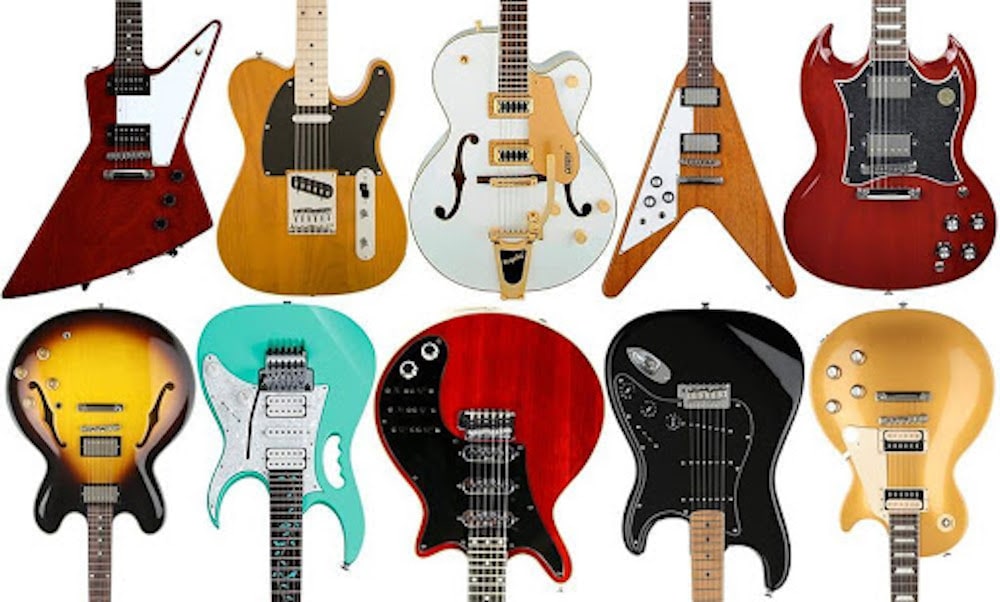Table of Contents
What is your primary criterion when selecting an electric guitar? The manufacturer, price, pickups, color, body shape, or sound? Unquestionably, these aspects will impact your decision to varying extents. However, foremost, you will direct your focus towards the aesthetics of the guitar, particularly its body contour. Nevertheless, mere visual appeal alone does not suffice in identifying a commendable guitar. Comprehending the constituents and arrangement of an electric guitar holds equal significance.
Numerous distinct body variations exist, encompassing diverse forms, styles, constructions, and even tonal qualities. Given the abundance of electric guitar types, selecting the appropriate one can prove challenging. Therefore, let us delve into the primary classifications of electric guitar bodies today, exploring their historical background and distinguishing characteristics. This way, you can discern the guitar that best aligns with your requirements.
Does the shape of an electric guitar affect the sound?
Multiple elements contribute to the tonal characteristics of a guitar: dimensions, mass, timber species, scale length, quantity and type of pickups, as well as body composition. The greater the resonant qualities possessed by a guitar body, the richer and potentially more sonorous the sound becomes. For instance, if a guitar features a diminutive body crafted from exceptionally compact and resilient timber, the sound will be pure but somewhat “metallic” in nature. In general terms, we can assert that an abundance of air within the body imparts a warm tonality, while body density yields a pristine and precise sound.
The complete array of electric guitar bodies can be categorized based on two primary aspects: construction and form.
You may find it intriguing to peruse the contents of this article: https://play-guitars.com/different-types-of-electric-guitars/
Case design
Electric guitars can be categorized into the following body designs:
- Guitars featuring a hollow body
- Guitars with a semi-hollow (or partially hollow with a block) body
- Solid-body guitars.
Over the course of the past century, the shape and configuration of electric guitars have undergone transformations, enabling you to select an instrument that aligns with your musical style, and aesthetic inclinations, or even pays homage to the instrument favored by your idol.
1. Hollow-body guitars
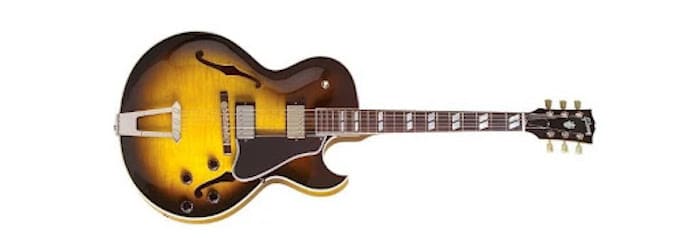
Also known as semi-acoustic guitars, these instruments have embraced the classical Spanish guitar’s customary shape while incorporating electronic components. Hollow body guitars continue to captivate numerous musicians, offering enhanced resonance, warmth, and a profound tonal quality that perfectly complements jazz and blues performances. Nonetheless, a notable drawback of hollow-body electric guitars lies in their propensity to generate feedback when amplified.
2. Guitars with a half-hollow body
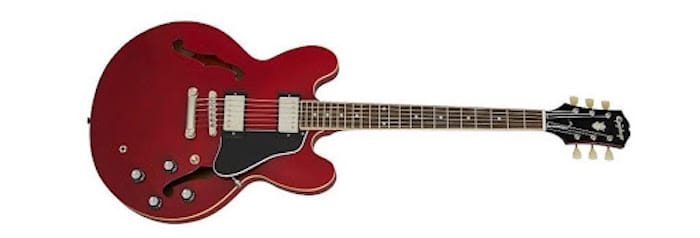
These guitars are meticulously crafted to amalgamate the benefits of hollow guitars, such as heightened resonance, while mitigating their drawbacks, namely reduced susceptibility to feedback. They often incorporate a solid center wood block, ensuring stability and fortitude in the instrument, thereby aiding in the prevention of feedback, albeit it may still manifest at high volume levels. Throughout history, these guitars have etched their indelible mark and found favor among countless legendary musicians.
Half-hollow body guitars can be envisioned as either hollow instruments fortified with a reinforced core or solid-bodied guitars imbued with hollowed sections. Typically, they exhibit a symmetrical body shape reminiscent of acoustic guitars, yet are adorned with two symmetrical cutouts. Esteemed by many blues artists, these guitars yield a warm tone, heightened attack, and prolonged sustain, making them well-suited for a diverse range of musical genres, spanning from blues and jazz to punk rock.
3. Solid body guitars
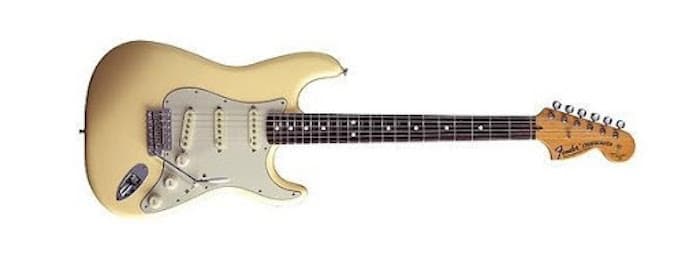
The entirety of an electric guitar’s body lacks acoustic chambers, relying solely on magnetic sensors to amplify and transform string vibrations into audible sounds. Since the 1950s, solid-body guitars have reigned supreme in both the realm of sales and the musical landscape. The solid body construction offers superior stability and, of paramount importance, effectively mitigates feedback. Consequently, it proves ideal for rock and metal performances, characterized by their high-powered nature. Moreover, the pristine sound produced by guitars with a solid body seamlessly integrates with a wide array of effects pedals, yielding predictable outcomes.
Shapes and Styles of Electric Guitar Bodies
Throughout the passage of time, the contours and aesthetics of renowned guitars like the FENDER Telecaster, Stratocaster, GIBSON Les Paul, and SG have commanded the realm of electric guitars, inspiring numerous manufacturers to replicate and emulate their design. Nevertheless, alongside these esteemed classics, a gradual yet resolute transformation has unfolded, giving rise to alternative styles and forms.
FENDER TELECASTER

During the 1950s, Leo Fender embarked on a quest to craft an economically viable guitar that would exude the vibrant and pristine tones synonymous with the country music of that era. The FENDER Telecaster, the world’s pioneering solid-body electric guitar with a bolt-on neck, emerged as a result. Originally christened the “Broadcaster,” its name swiftly transformed to Telecaster to circumvent copyright concerns, eventually securing its place as the best-selling guitar in history. The streamlined, slender fingerboard, comprising a single piece, streamlined production, and enhanced cost-effectiveness. Rapidly gaining favor across a diverse range of musical genres, the Telecaster resonated with musicians hailing from country, blues, jazz, and rock backgrounds alike. Its luminous and crystalline timbre captivated artists across the musical spectrum, while its solid body construction harmonized seamlessly with the burgeoning popularity of distortion, generating minimal feedback even at elevated gain levels.
The FENDER Telecaster boasts body options of ash or alder. The timeless guitar showcases a classic fingerboard with 21 frets (25.5″), crafted from a single slab of maple without a separate fingerboard, fastened securely using four bolts. All pickups are arranged in a single row, while the guitar houses two single-coil pickups, with all electronics mounted on the pickguard. The strings are anchored through the body, accentuating the guitar’s resonance.
Esteemed musicians who have wielded or continue to embrace the FENDER Telecaster include the likes of Keith Richards, George Harrison, Kurt Cobain, and an array of other notable artists.
FENDER STRATOCASTER
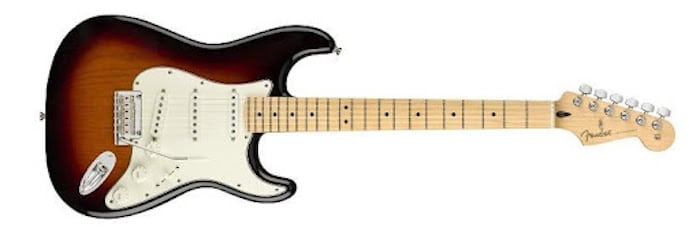
The FENDER Stratocaster, an instrument of unparalleled popularity, holds the esteemed title of the most revered electric guitar in history. Its iconic silhouette and resounding tones have served as the inspiration for countless imitations from various guitar manufacturers. Unveiled in 1954, the Stratocaster followed in the footsteps of its predecessor, the Telecaster, with an aim to strike a harmonious balance between affordability and exceptional sound quality. It boasted a bright, mellower tonal character compared to the Telecaster, accompanied by smooth, contoured edges, a trio of pickups with a versatile 5-position switch, and an ornamental façade known as the pickguard. Embracing the vintage tremolo system as its foundation, which solely functions to lower the pitch, this mechanism is affixed to the body with six screws.
Equipped with three pickups, the Stratocaster bestows a gamut of sonic possibilities to cater to your musical preferences. Renowned as the quintessential electric guitar for blues, its timeless midrange timbre beautifully complements blues performances. However, the Stratocaster’s versatility extends far beyond the blues genre. The inclusion of a 5-position switch facilitates a vast array of tonal variations, rendering the Stratocaster suitable for nearly every musical style. Be it blues, rock, funk, metal, or myriad other genres, the FENDER Stratocaster effortlessly delivers pristine and articulate sounds even at lower gain levels, making it an excellent companion for the utilization of effects pedals.
The guitar’s body material is crafted from either ash or alder, while the neck, secured by four bolts, features 21 to 22 frets. With a scale length measuring 25.5 inches, all the pickups are positioned in a single row, epitomizing the Stratocaster’s iconic design.
Esteemed musicians such as Eric Clapton, Jimi Hendrix, David Gilmour, Mark Knopfler, Stevie Ray Vaughan, and countless others have ardently chosen the FENDER Stratocaster as their instrument of choice, recognizing its unrivaled quality and sonic prowess.
SUPERSTRAT

A paradigm of versatility in the realm of electric guitars, the Superstrat stands as an instrument distinct from its progenitor, the Stratocaster, boasting a purpose and configuration all its own. The quintessential shared attribute lies in the contours of their guitar bodies. However, the Superstrat diverges with its utilization of pickups imbued with augmented power, rendering them exquisitely suited for the realms of metal and hard rock. Moreover, the Superstrat often incorporates a Floyd Rose tremolo system, amplifying the range of string oscillation to surpass that of a standard Strat tremolo, all while maintaining superior tuning stability. Certain models feature pickups that emanate a vintage tonal palette, revered in the realms of jazz-fusion and neo-soul, exemplified by the illustrious IBANEZ AZ series.
Renowned for their Superstrat designs, IBANEZ guitars have etched an indelible mark upon the musical landscape. Notably, the IBANEZ RG470 emerges as a preeminent Superstrat model in the highly coveted HSH configuration. Another notable contender, the SCHECTER OMEN EXTREME 6 FR, embraces the Superstrat aesthetics and is graced with the resonant prowess of dual humbuckers. For those seeking a more budget-friendly alternative in the HSS configuration, the YAMAHA PACIFICA PAC112V extends an inviting proposition.
Elevating the Superstrat to new heights, virtuosos such as Eddie Van Halen, Steve Vai, and Dave Murray have deftly harnessed its potent capabilities, leaving an indelible imprint upon the annals of musical history.
GIBSON LES PAUL
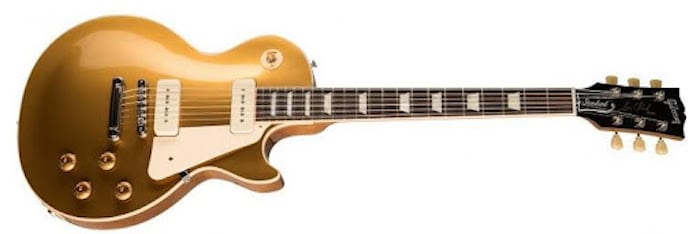
Should one’s musical allegiance not lie with FENDER, the mantle of admiration likely falls upon the hallowed name of LES PAUL (though it must be noted that one need not exclude the other). Emerging in 1952, the Gibson Les Paul electric guitar unveiled itself as the inaugural mass-produced solid-body contender to challenge the Telecaster’s reign. Not until 1957 did the Les Paul acquire its iconic humbuckers. It is astonishing to conceive that a guitar which now rivals the Stratocaster in eminence once faced a lackluster reception, even enduring a discontinuation from 1961 to 1968. Yet, Gibson’s fortune took a turn, for the Les Paul wielded a singular sonic identity, its humbuckers yielding a resonance of grander girth and potency compared to the slender Fender single-coils, alongside a superlative sustain. These very qualities propelled the Les Paul to ascendancy, captivating an eclectic array of genres and virtuosos.
Primarily acclaimed within the realm of rock music, the Les Paul encompasses a realm far vaster. Its sonorous character exudes a warm, pristine timbre, encapsulated within the adjectives “thick” and “resplendent.” Clad in the guise of Les Paul style, often referred to as LP style, this instrument spans the sonic spectrum, accommodating an expansive palette of genres. Within its embrace, one discovers its soulful resonance animating jazz, metal, R&B, and the kaleidoscope of rock and punk’s myriad permutations.
Manifested in the resplendence of mahogany, the guitar’s body material exudes an aura of sophistication, with the maple adorning its resplendent top. The fingerboard, meticulously affixed to the body through the art of adhesion, is hewn from the very heart of mahogany. Embellished with rosewood, the fingerboard comprises a triumphant expanse of 22 frets, guided by a 24.75-inch scale length and an enchanting triptych arrangement of pins. A symphony of humbuckers often graces the Gibson Les Paul, though certain iterations dare to bear the fruit of three. Firmly tethered to the body, the strings find solace in the embrace of the Tune-o-Matic bridge.
A pantheon of artists, spanning a rich tapestry of musical luminaries, have heeded the call of the Les Paul: Jimmy Page, Slash, Paul McCartney, Frank Zappa, Zakk Wylde, Gary Moore, Bob Marley, Ace Frehley.
GIBSON SG
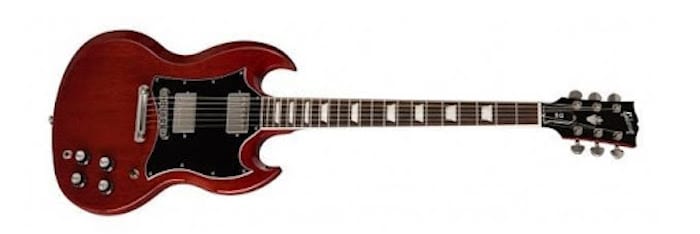
In the year 1961, as the resplendent Les Paul reached the zenith of its prominence, the Gibson SG unveiled itself on the world stage. It is worth noting that the guitar initially bore the name Les Paul SG (“Solid Guitar”). However, Les Paul himself, harboring dissatisfaction with the instrument’s design, beseeched that his name be expunged, leaving behind only the distinguished SG. Despite the eventual return of the original Les Paul, which ascended to greater prestige, the SG reigned as Gibson’s unparalleled bestseller, perpetually crafted since its inception.
Exhibiting striking similarities to its Les Paul counterpart, the SG boasts a slimmer body with twin cutaways and a more slender fingerboard, facilitating swifter and more effortless access to the celestial realm of higher notes. The SG’s fingerboard joins the body at the 22nd fret, whereas the Les Paul’s union occurs at the 16th. To the discerning soloist who traverses the fretboard’s final reaches, this discrepancy proves palpable.
Wood selection, fingerboard construction, fret count, tuner placement, electronic configuration, Tune-o-Matic pickup, and even the resonant chamber remain identical to those adorning the Les Paul.
The illustrious roster of artists who have anointed the Gibson SG with their artistry includes Angus Young, Tony, Robbie Krieger, Frank Zappa, Derek Trucks, Jerry Garcia, Mike Ness, Mick Taylor, and Eddie Vedder.
OFFSET GUITARS
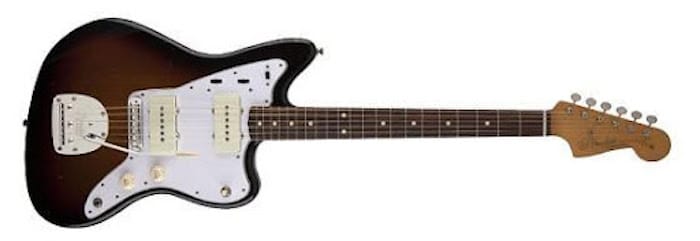
The realm of offset body style encompasses three prominent archetypes of electric guitars: the Jaguar, Mustang, and Jazzmaster. While subtle nuances differentiate them, all offset guitars exude a resplendent and crystalline timbre, with a delicately nuanced response within the mid and low frequencies. These guitars excel in rhythmic playing, their vibrant tonality endearing them to alternative musicians who sought an instrument within their reach during the 1990s grunge era. The sonic lucidity inherent in these guitars renders them well-suited for genres that embrace a myriad of effects, hence their prevalence in shoegaze (or Dream-pop) and other alternative soundscapes.
The Jaguar and Jazzmaster typically employ 1-meg potentiometers, lending their core tonality a bright and incisive quality, capable of triumphantly surmounting a plethora of modulations and effects. On the other hand, the traditional Mustang guitars feature 3-position switches for each pickup. In the central position, they yield a tone akin to that of a telecaster, while different configurations unlock a unique and phase-contrasting sound, defying conventional norms.
Furthermore, guitars such as the Jaguar and Jazzmaster boast an enchanting floating tremolo. Though less tempestuous compared to the Floyd Rose variant, it bestows a subtle embellishment upon chords, ideal for invoking a touch of elegance. For an instant foray into the realm of surf rock, explore the synergistic fusion of the floating tremolo with reverb.
Distinguished performers who have embraced the allure of these offset wonders include Johnny Marr, Thurston Moore, Jay Maskis, Kevin Shields, and Kurt Cobain.
Conclusion
Since the divergence of electric guitars from the venerable Spanish guitar form, a multitude of distinctive designs and styles have emerged. While certain shapes and styles may be erroneously linked to specific musical genres or fleeting trends, it becomes apparent that the connection between form and sound is not always absolute. Many musicians possess a diverse array of guitars, selecting them based on their context, temperament, or performance requirements. The guitarist’s experience while playing holds paramount significance, and it is molded by a fusion of visual aesthetics, auditory resonance, and the intimate dance of mechanical muscle memory.
When embarking upon the acquisition of a guitar, the allure of its shape may indeed exert a gravitational pull upon your inclination, yet it is imperative to recognize that aesthetics alone cannot ascertain the quality of the instrument. Beyond superficial appearances lies a realm of profound importance—an understanding of the constituent elements and intricate configuration of electric guitars. May your choice be guided by sagacity, leading you to discover an instrument of exceptional delight and gratification!


